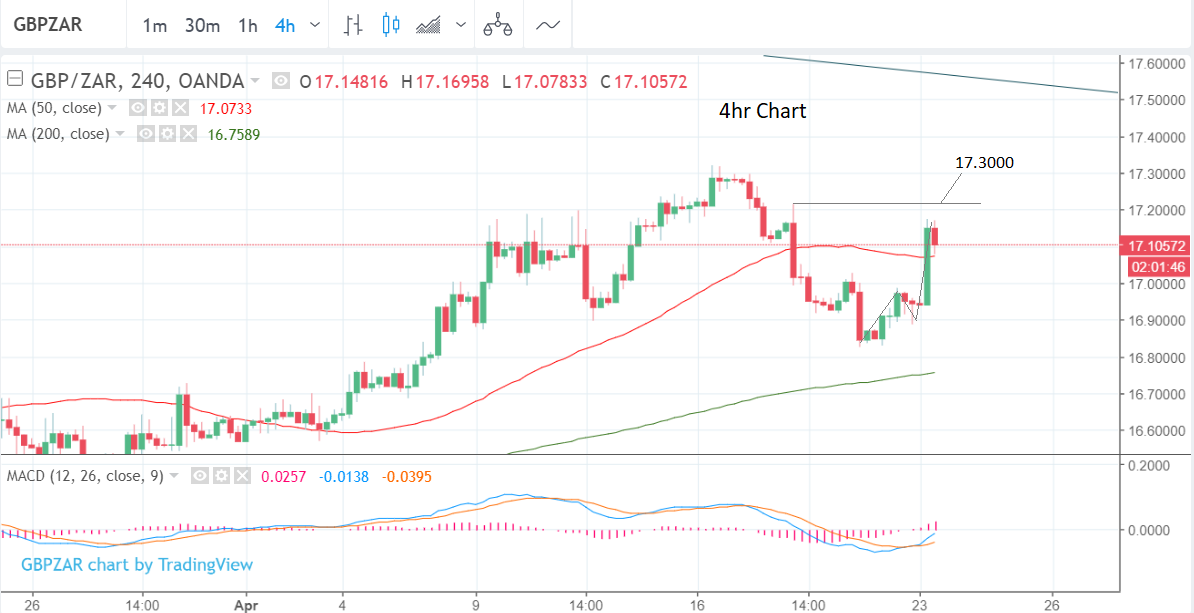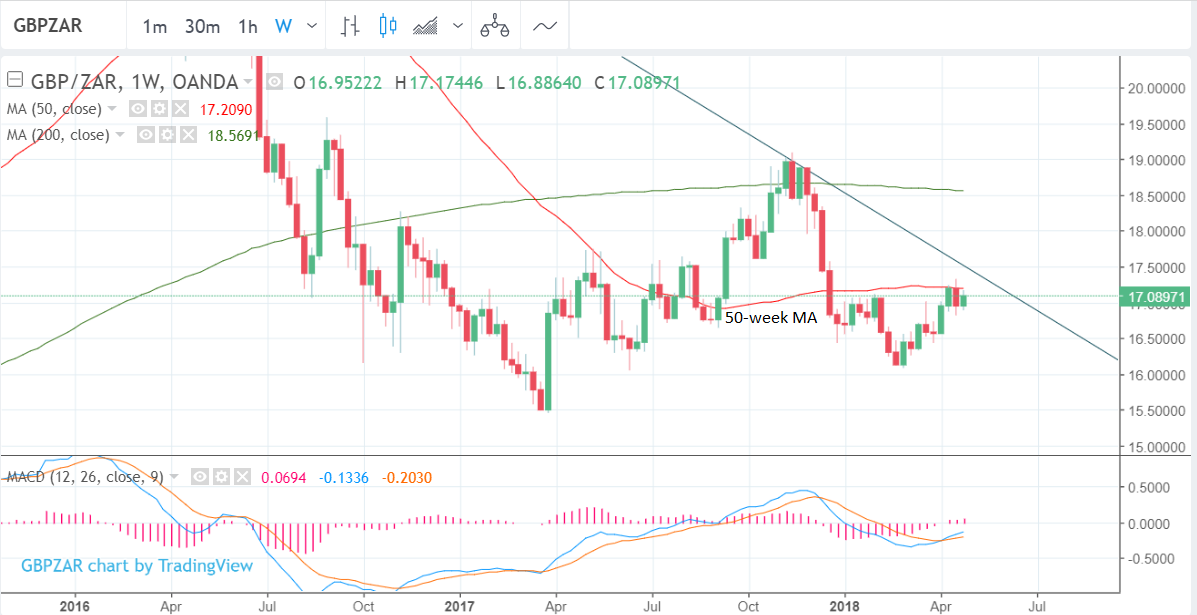Pound-to-Rand Rate Forecast for Week Ahead
- GBP/ZAR is back up above 17.00 to the Pound as the new trading week begins
- The main release for Sterling is Q1 GDP data out on Friday
- For the Rand, Producer Prices out on Wednesday could help provide insight on interest rate trajectory

© kasto, Adobe Stock
One Pound buys 17.07 Rand at the start of the new trading week, up from 16.95 at the end of play last Friday.
The Pound-to-Rand exchange rate rose up to and met our previous target at 17.30, as we successfully forecast in our previous week ahead, but then quickly corrected back down to the lows of 16.80. It has now regrouped and appears to be starting to climb back up to retouch the old 17.32 highs.
Our latest technical studies lead us to believe it will continue up and retouch the same 17.30 target as before, although would ideally like to see confirmation from a break above the 17.2150 highs (see chart below) established on April 18, before expecting such follow-through.
Beyond that, we see further upside as being capped by tough resistance from the 200-week moving average at 17.3049.
Large moving averages often act as obstacles to the trend as price action often stalls, pulls-back or even reverse at them due to the increased trading activity around them.
They are extremely popular indicators which many investors use as a basis for their buying and selling decisions, thus supply and demand dynamics are often magnified around them.
Get up to 5% more foreign exchange by using a specialist provider to get closer to the real market rate and avoid the gaping spreads charged by your bank when providing currency. Learn more here.
Data and Events to Watch for the South African Rand
There are no top-tier data releases in the week ahead for the Rand but there are important second-tier releases such as PPI, or Producer Price inflation, Consumer Confidence and the South African Reserve Bank's (SARB's) composite business cycle monitor.
However, for ZAR it appears to be sentiment - both domestic and global that is in the driving seat.
"with the market already pricing in a significant amount of good news, the catalyst for the second leg of a ZAR rally could come from evidence of a structural economic recovery or an early election," says Ellie Heatherill, CEEMEA FX Strategist at Morgan Stanley.
Heatherill does however strike a constructive tone on the currency noting:
"Despite the recent downside CPI surprise, our economist believes the SARB’s easing cycle is over, which will be good for short-term investors seeking carry on ZAR FX but also real money investors exposed to the bond market. We expect bond and equity inflows to keep ZAR supported," says Heatherill.
Much may depend on whether the SARB continues to cut interest rates, as this could weigh on the Rand and a key determinant of this decision-making process will be changes to the inflation rate, which means this week's Producer Price Inflation (PPI) release may be of more significance than usual.
PPI is often taken as an early warning indicator of changes to broader CPI inflation reading because it covers the cost of articles coming off the production line so it impacts on wholesale costs. Higher PPI usually precedes higher CPI.
The general consensus is that PPI will rise by 0.5% in March compared to a -0.3% fall in February, and by 4.0% compared to a year ago from 4.2% previously, when it is released at 10.30 GMT on Thursday, April 26.
Official Consumer Confidence is expected to show a small uptick in March when it is released on Wednesday.
Tuesday sees the release of the SARB's economic business cycle monitor, which is expected to provide a useful snap-shot for investors to check the short-term economic health of the country.
Ongoing strikes in South Africa reflect the problems the authorities are having negotiating lower wage rises with unions.
"The fact that a settlement is likely to be reached somewhere in the middle of the remaining gap of 8% to 9.5%, well above the current rate of inflation, shows how tough it will be for employers – including the government, which is currently in tough public-sector pay talks, to get unions to agree to moderate nominal wage demands in line with the reduction of inflation and inflation expectations," reads a briefing on the matter issued by ABSA.
The high nominal wage agreements indicate the possibility of continuing inflation pressures which are probably likely to keep interest rates, and therefore the Rand supported, in the medium-term.
News and Data to Watch for the Pound
The main release for the Pound in the week ahead is the first release of GDP growth data for the first quarter of 2018, which is out at 9.30 GMT on Friday, April 27.
Expectations are for growth to slow slightly to 0.3% quarter-on-quarter (qoq) compared to 0.4% in Q4 and to remain unchanged at 1.4% compared to the year before (yoy).
This is no doubt due to the bad weather in Q1, but given growing doubts about the UK's economy in general the market may be expecting a lower result, which would further lower the probability of the BOE raising interest rates in May.
From being 96% certain the BOE would hike interest rates two weeks ago, the market is now only 50% sure - a lower GDP reading would reduce that even further. Generally higher interest rates equal a stronger currency and vice-versa as higher rates attract inflows from foreign investors drawn by the promise of higher returns.
Some analysts are even more pessimistic about Q1 growth.
"We are penciling in a slowing in the growth pace from +0.4% qoq in Q4 2017 to +0.2% in Q1. Furthermore, if anything, risks look to be to the downside of a +0.2% print," says Ryan Djajasaputra of Investec.
Although Djajasaputra puts it down almost entirely to bad weather rather than anything else, and thus a temporary negative.
"We suspect that Q2 GDP will not look quite as soft, especially with the household cash squeeze slowly turning around," adds the analyst.
Apart from GDP data, there are no other top-tier releases for the Pound in the coming week, but GfK Consumer Confidence is expected to continue showing a negative -7 reading in April when it is released on Friday at 00.01.
There are also three surveys from the Consortium of British Industry (CBI), the Business Optimism Index and the Industrial Trends Orders at 11.00 on Tuesday, followed by the Distributive Trades survey on Thursday at 11.00, which is forecast to show a rise to 5 from -8.
In addition, Public Sector Borrowing figures for March are out on Tuesday at 9.30.
Get up to 5% more foreign exchange by using a specialist provider to get closer to the real market rate and avoid the gaping spreads charged by your bank when providing currency. Learn more here.







